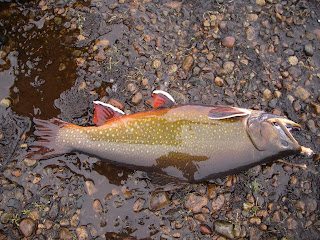Do you want to improve your distance casting? Better start with your casting accuracy. If your still struggling with turning over the leader, bet your britches your going to struggle throwing a long line. Here are a few pointers to improve casting accuracy to allow you to throw that fly a country mile.
To improve your accuracy you must first make sure that the rod is tracking properly through the cast. Take your target and invision a line going forward through your target and all the way behind you stretching to infinity. This immaginary line is the line that the rod must track to cast accuratly. Most anglers have no problem tracking the rod through the front cast. Their mistake comes on the back cast.
My first bit of advise is to improve your back cast. The back cast is a fundamental and a must for accuracy and distance. Here is an easy excersize to help you build the necessary muscle memory for the back cast. Take your hand as though you were holding your fly rod. Stand approximatly 18 inches from the wall with your casting hand resting on the wall slightly less than sholder high. Move your hand back and forth on the wall as though you were casting a fly. This helps you understand that your casting hand must maintain the plane of the wall to track the rod in plane. You can also stand infront of a mirror with just the but end of a fly rod. Take a comfortable grip on the rod and make your typicall casting stroke. Watch to see if the end of the rod comes out of plane. Work on this new casting stroke. You should understand that you can maintain this casting plane and track the rod tip 180 degrees around your body, but the back cast must track in the same plane as your target on your front cast.
Take your new casting stroke to the yard. Put a target out infront of you. Start with a short cast and try to track the rod on the same line or plane through the cast and drop your fly on the target. You will notice that with short casts the casting stroke will be short and fast. As you put the target further away the casting stroke should lengthen as should the time you pause between front and back cast. If your casting stroke does not lengthen, or your not waiting for the rod to load properly you will begin throwing a tailing loop. Work on distances that are comfortable and be sure that the leader is turning over properly. Once you can drop the fly on target, work on longer distances. You will eventually reach a point where the amount of line you carry durring a cast is too long, then you need to learn to shoot line, and double haul. We can cover that in another blog.
To improve your accuracy you must first make sure that the rod is tracking properly through the cast. Take your target and invision a line going forward through your target and all the way behind you stretching to infinity. This immaginary line is the line that the rod must track to cast accuratly. Most anglers have no problem tracking the rod through the front cast. Their mistake comes on the back cast.
My first bit of advise is to improve your back cast. The back cast is a fundamental and a must for accuracy and distance. Here is an easy excersize to help you build the necessary muscle memory for the back cast. Take your hand as though you were holding your fly rod. Stand approximatly 18 inches from the wall with your casting hand resting on the wall slightly less than sholder high. Move your hand back and forth on the wall as though you were casting a fly. This helps you understand that your casting hand must maintain the plane of the wall to track the rod in plane. You can also stand infront of a mirror with just the but end of a fly rod. Take a comfortable grip on the rod and make your typicall casting stroke. Watch to see if the end of the rod comes out of plane. Work on this new casting stroke. You should understand that you can maintain this casting plane and track the rod tip 180 degrees around your body, but the back cast must track in the same plane as your target on your front cast.
Take your new casting stroke to the yard. Put a target out infront of you. Start with a short cast and try to track the rod on the same line or plane through the cast and drop your fly on the target. You will notice that with short casts the casting stroke will be short and fast. As you put the target further away the casting stroke should lengthen as should the time you pause between front and back cast. If your casting stroke does not lengthen, or your not waiting for the rod to load properly you will begin throwing a tailing loop. Work on distances that are comfortable and be sure that the leader is turning over properly. Once you can drop the fly on target, work on longer distances. You will eventually reach a point where the amount of line you carry durring a cast is too long, then you need to learn to shoot line, and double haul. We can cover that in another blog.
